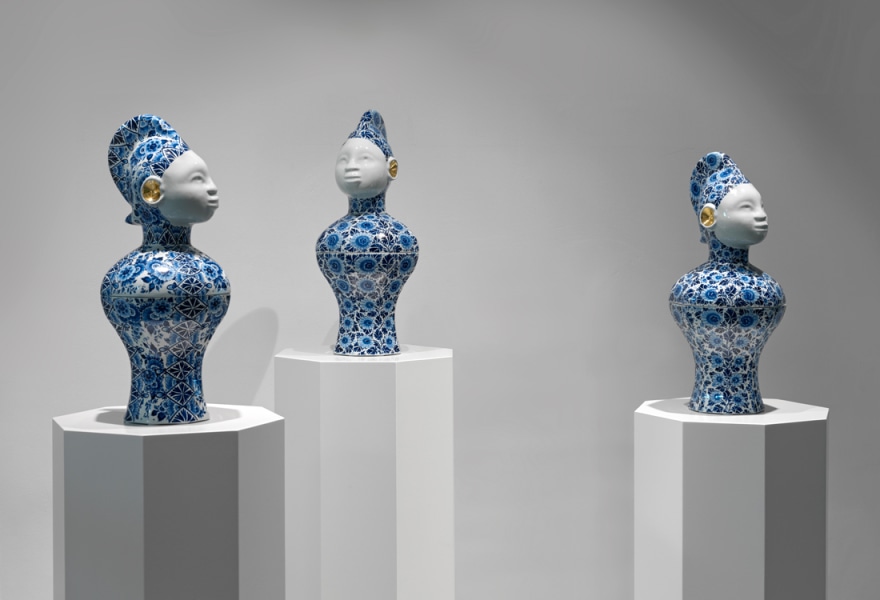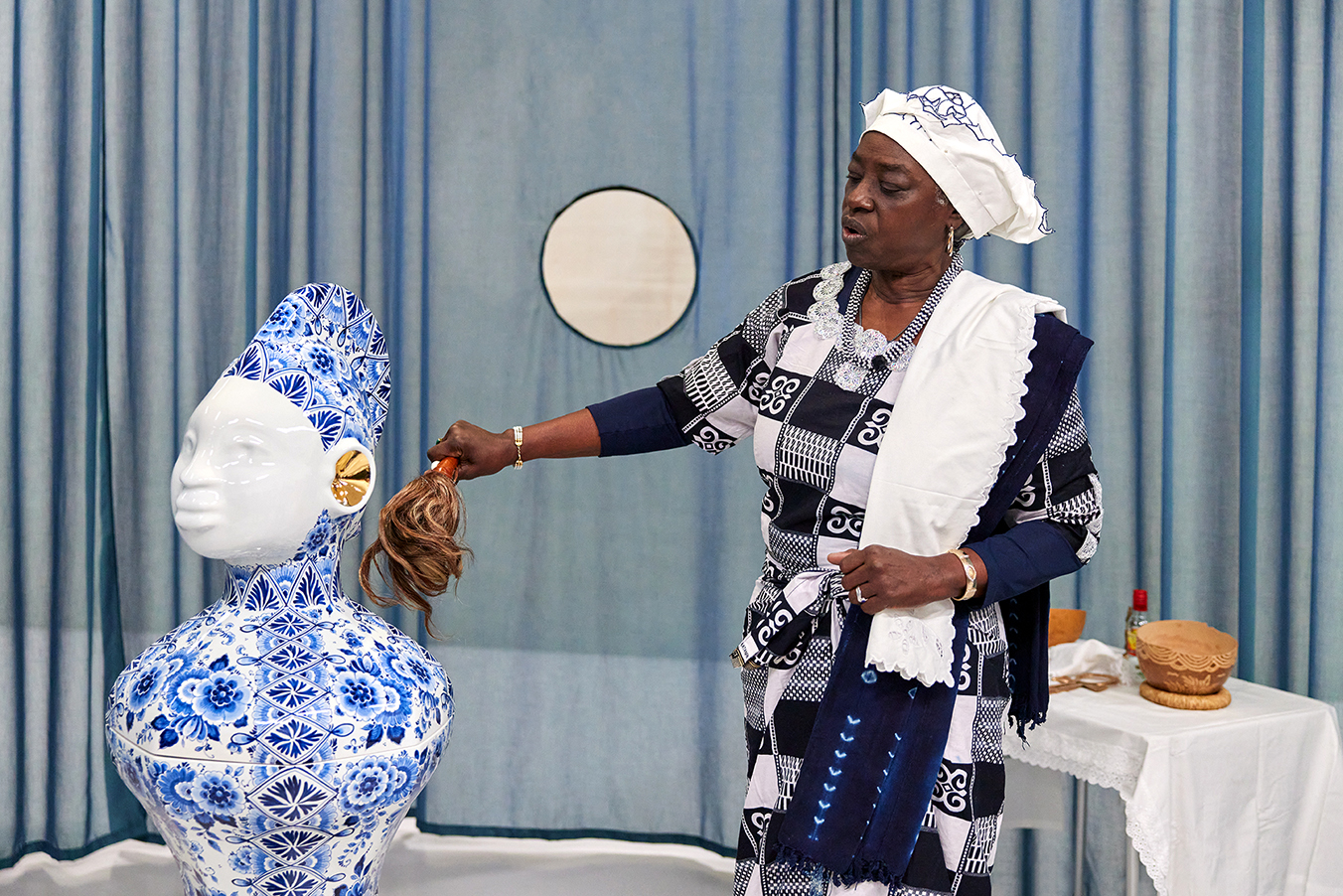27 march 2024, Wouter van den Eijkel
Kabra Blauw at Galerie Fontana
Contemporary Ceramics Collective, a group exhibition featuring the work of eight internationally renowned ceramicists, opened with a libation by Winti priestess Marian Markelo. Different yet not entirely unexpected, as Markelo has been collaborating with Rotterdam-based artist Boris van Berkum for years on a Winti art collection. Three ornamental vases from the Kabra Blauw ('Kabra Blue') collection are currently on display at Galerie Fontana.
At Fontana, I'm exhibiting three ornamental vases from the Kabra Blauw collection. The shape is reminiscent of the Egyptian canopic jars: a vase topped with a head. Each ornamental vase is 60 cm tall, made of white faience and hand-painted with Delft blue by master plate painter Diana van Zeijl from Heinen Delfts Blauw, the Delft blue manufacturer with whom I developed Kabra Blauw. The spiritual initiator is Winti priestess Marian Markelo, with whom I have been working on an expanding body of art related to Winti since 2010. The ornamental vases at Fontana are part of this body of work.
The collection has been around for several years and has achieved its goal, which became apparent when I noticed that the king was wearing a brooch from the series during Keti Koti last year.
Not only did King Willem Alexander reiterate the government's apologies for 400 years of Dutch slavery, but as head of the royal family, he also asked for forgiveness for its role in the slave trade. This acknowledgment has been a significant milestone and I believe the Netherlands needs more time to come to terms with the painful history of 400 years of slavery as a shared past. The fact that the king wore the Kabra commemorative pin was incredibly exciting for me as a designer.
Finding a good gallery that suits an artist takes time. Fons Hof (director of Art Rotterdam, ed.) helped me out with advice and Fontana turned out to be the best match, one that has proven to be a good fit. Right now, I am a guest artist at Fontana, which may result in a more permanent representation in the future.
The name of the collection, Kabra Blauw, is a combination of Kabra and Delft Blue. Kabra is a term from the Winti belief. Can you briefly explain this?
The ‘Kabra’ (literally translated as ‘Ancestors’) play a significant role in Winti culture. Winti is an Afro-Surinamese spiritual way of life, a fusion of West African god concepts of enslaved Africans who ended up in Suriname during the transatlantic slave trade. The Winti (literally translated as ‘Wind’) of the earth, air, water and forest were created by the creative god Keduampon to assist humans in their growth and development on earth.
The essence of Winti revolves around being together with others and having time for each other, both with living people and deceased ancestors. The emphasis is on spirituality and not on dogma; Winti is not hierarchical. I love the fact that the Winti gods and ancestors are celebrated with dance rituals, music and good food and drink, without thundering sermons about guilt and shame. As a human being, you are encouraged to be yourself and to develop to the best of your abilities.
What do Kabra and Delft Blue have in common?
They are both ancestral traditions recognisable by the colours blue and white. I got the idea for Kabra Blauw during an ancestor ritual. All attendees wore blue and white because in Winti culture, this colour combination represents the Kabra, the ancestors. Blue symbolises the West African royal lineage, while white represents death and purity. I thought, "I'm in a Delft blue dream," and then I realised that blue and white are also my Dutch ancestral colours! Since the 17th century, Delft blue has been an integral part of Dutch tradition. What happens when we bring these two cultures together in a single ornamental object? Does something like Kabra Blauw emerge? From that line of thought, I created the Kabra Blauw collection.
Honestly, I was also quite surprised that a Black Winti priestess invited me, a white artist, to produce a Winti art collection. The goal of the new Winti art collection: an African revival of art in the Winti ritual. This practice had been forgotten on the Protestant plantations of Suriname. I was even more surprised when I heard that her ancestors had designated me as the chosen artist.
Now I understand that much better. The collaboration between Black priestess Marian Markelo and a white artist Boris van Berkum is not accidental and even conveys an important message: that we need each other in the process of dealing with the slavery past and creating a new collective story.
Marian says, "Our Winti artworks are the symbols of the future, one in which we work together on an equal and respectful basis, a future in which we celebrate our cultural differences and bring them together into something new and beautiful."
The approach to the design process for the new Winti art collection may seem a bit odd. I assemble and model forms obtained through 3D scans of art objects, including from ethnographic museum collections, with 3D scans of living models and contemporary objects. In Kabra Blauw, for example, I placed an ancestor mask of the Egungun Yoruba (Africa Museum collection) on the shape of a 17th-century octagonal lidded vase from the Boijmans collection.
When Winti priestess Marian Markelo asked you to join this project, did you immediately want to be part of it? Did you know anything about Winti culture?
Yes, I knew I had to do this; I find art in a spiritual context fascinating. In 2010, Winti priestess Marian Markelo commissioned me to develop and produce a new Winti art collection. I actually knew very little about it. So, I spent three years doing a 'Winti internship' with Marian, conducting extensive research on Winti, the history of slavery and African art collections in Dutch museums. I also went on study trips to Ghana, Togo Benin, and Suriname and attended countless Winti rituals. It wasn't until 2013 that I created the first real work: the Kabra ancestor mask. This mask dances every year at Winti ancestor rituals and accompanies Marian Markelo every year when she presents the libation in memory of the ancestors during the National Commemoration of Dutch Slavery Past on Keti Koti. The Amsterdam Museum acquired it in 2014 on the condition that we could continue to use it.
I noticed that the series is broader than just these sculptures. There are also utensils, brooches and salt shakers. What made you decide to include these?
The Kabra Blauw collection includes Kabra Blauw ornamental vases (artworks), a Kabra Blauw salt shaker and a Kabra commemorative pin. I designed the salt shaker and the pin for the Slavery Past Commemorative Year. NiNsee (National Institute of Dutch Slavery Past and Heritage) has designated the Kabra Blauw Salt Shaker as the souvenir of the Slavery Past Commemorative Year. "The shaker allows the conversation about the history of Dutch slavery to be held at the kitchen table," said Linda Nooitmeer, chairperson of NiNsee. The salt shaker has since become the absolute bestseller in the Dutch Museum Giftshop's webshop and is available in 30 museum shops across the country. The Kabra commemorative pin now has a circulation of 20,000 pieces. I think it's important that art ownership, no matter how small, is accessible to everyone. In this sense, I am following in the footsteps of our collective art predecessor Keith Haring with his Pop Shop.
Do you want to expand the project further and if so, what can we expect?
In the long term, I would like to create a large historical work, a kaleidoscopic vision, in which the entire story of Winti is depicted, the cosmology of Winti as it were. In the short term, a set of two Kabra Blauw ornamental vases has been purchased by Museum Boijmans Van Beuningen and will be on display until March 2025 at the Depot in the exhibition 'Beloved, highlights from the collection'.



